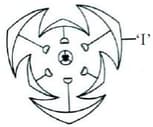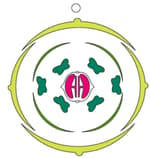Rutaceae differs from Malvaceae in having
Important Questions on Morphology of Flowering Plants
Which of the following are the characteristic features of the family Fabaceae?
I. Gamosepalous nature
II. Stamens five, epipetalous
III. Marginal placentation
IV. Petals five, polypetalous
V. Fruit is a berry
The correct answer is:
Match Column - I with Column - II.
| Column-I | Column-II | ||
| (a) |  |
(i) | Brassicaceae |
| (b) |  |
(ii) | Liliaceae |
| (c) |  |
(iii) | Fabaceae |
| (d) |  |
(iv) | Solanaceae |
 is the floral formula of:
is the floral formula of:
Botanical names of plants are given in Column I, and the family/order name in Column II. Choose the appropriate combination from the options below.
| Column I | Column II | ||
| (P) | Tamarindus indica | (i) | Arecaceae |
| (Q) | Cocos nucifera | (ii) | Liliaceae |
| (R) | Colchicum autumnale | (iii) | Solanaceae |
| (S) | Withania somnifera | (iv) | Papilionaceae |
Medicinally important plant and a tendrillar climber with unisexual flowers
Spice yielding plant with cymose inflorescence, persistent calyx, unilocular ovary
Oilseed plant with monadelphous stamens, unilocular ovary, and indehiscent pod
Identify the floral unit 'I' in the given floral diagram.

| LIST-I | LIST-II | LIST-III | |||
| A | Atropa | i | Ormament | I | Number and codes |
| B | Computer usage in taxonomy | ii | Medicine | II | Pterocarpus |
| C | Gloriosa | iii | Fabaceae | III | Solanaceae |
| D | Odd sepal anterior | iv | Numerical Taxonomy |
IV | Rhizome |
The correct match is:
A) For classification of higher organisms we need to know technical terms and variation of the parts
B) Roots arise from radicle are called fibrous roots
C) The modified bract is called "Spathe"
D) In Apiaceae family, each flower is surrounded by involucre of bracts.
Choose the number of modifications in Allium cepa.
Tunicated bulb; reduced stem; adventitious roots; umbel inflorescence; solid leaves; fleshy leaf bases; involucre of bracts
One of the families is characterized by the following floral formula:

Identify the family:
Choose the correct floral formula of the given floral diagram.

Study the following table :
| I. | Polysiphonous Pollen | Floral nectaries | Simple Sieve plates |
| II. | Angular collocyte | Monosiphonous | Synandry |
| III. | Inserted stamens | Simple leaves | Spines |
| IV. | Exerted Stamens | Reticulate divergent venation |
Pepo |
Select the correct pair of answers in which the former in the pair shows the set of characters present in Cucurbita and the latter in the pair shows the set of characters absent in Acacia.

